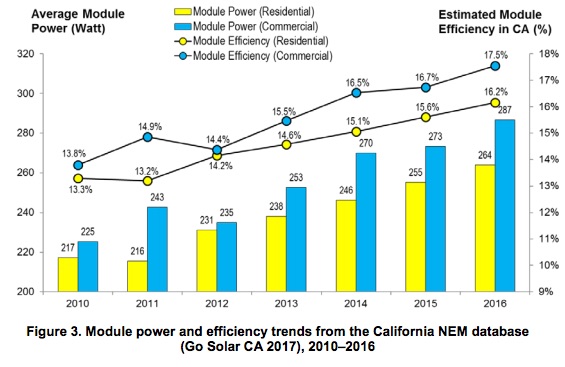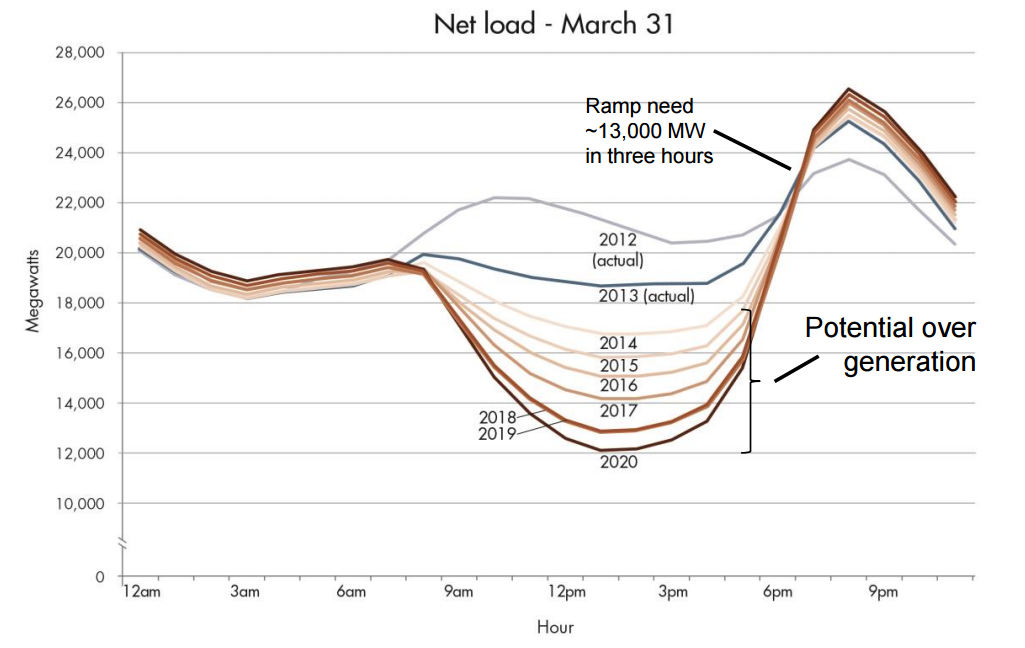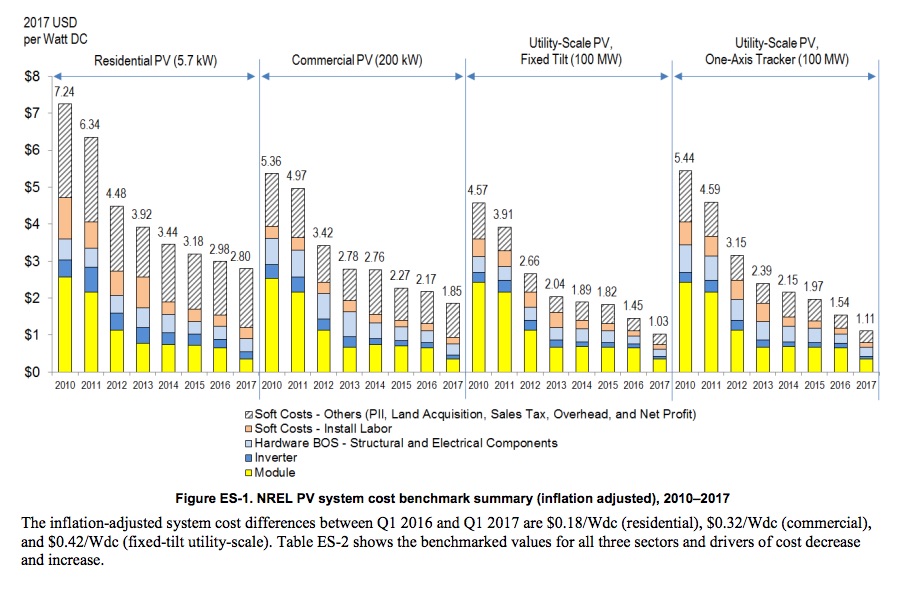Solar power isn’t dead in the Trump Administration. Instead, the Dept of Energy announced last week that the 2020 SunShot cost reduction goals were met, and therefore the focus of the Solar Energy Technologies Office would shift to longer-term goals such as Grid Reliability and Energy Storage.
“With the impressive decline in solar prices, it is time to address additional emerging challenges,” said Daniel Simmons, Acting Assistant Secretary for Energy Efficiency and Renewable Energy. “As we look to the future, DOE will focus new solar R&D on the Secretary’s priorities, which include strengthening the reliability and resilience of the electric grid while integrating solar energy.”
(Aside: that Daniel Simmons’ title has the word “Acting” indicates the Trump Administration has yet to appoint a permanent person for that job — almost 10 months into the Trump Administration)
The announcement says the DoE is switching focus “Largely due to rapid cost declines in solar photovoltaic (PV) hardware, the average price of utility-scale solar is now 6 cents per kilowatt-hour (kWh).” However, we’ll note that in April, Energy Secretary Perry ordered a Study of whether renewable energy systems “erodes energy security”. At the time I thought such a study would provide cover for dumping solar power technology in favor of coal because conventional wisdom says coal provides energy security. But, instead by refocusing the Solar Energy Technologies Office on grid reliability via energy storage, they’re following right along with the recommendations I made in my earlier post.
The image above (from a DoE report on solar costs![]() ) demonstrates the economic reality. The cost for solar power systems is falling rapidly. Soon, if this isn’t already the case, solar (and wind) power will be directly financially competitive against incumbent fossil fuel systems. Over the last couple years the overwhelming majority of installed electrical generation capacity in the USA has been Wind and Solar. The reason would be this sort of cost reduction curve.
) demonstrates the economic reality. The cost for solar power systems is falling rapidly. Soon, if this isn’t already the case, solar (and wind) power will be directly financially competitive against incumbent fossil fuel systems. Over the last couple years the overwhelming majority of installed electrical generation capacity in the USA has been Wind and Solar. The reason would be this sort of cost reduction curve.

It’s obvious that this would be the result. An honest unbiased choice between wind/solar and fossil fuel electricity systems would clearly increasingly choose solar (or wind) power. Hence, there is a rapid growth of solar adoption in the USA. (Big question — will this curve taper off during the Trump Administration and its fossil-fuel-friendly leadership?)

The growth rate in California is especially strong. Again, both of these charts cover time up until 2016, and we have yet to see what the impact of the fossil-fuel-friendly Trump Administration is. Maybe the economic facts are strong enough to keep the ball rolling regardless of what the current Administration wants.

Another aspect of why the costs are falling and bang-for-the-buck is increasing is due to improvements in the technology. Increased efficiency means that a solar array with newer panels will produce more electricity than an equal sized array with older panels.
There’s a lot of good information in the report including a graph showing similar decreases in the Levelized Cost of Energy for solar power systems. But, the DoE made a second announcement we need to go over.
Shifting focus to Grid Reliability and Energy Storage
The increased adoption of solar power is great – it means more and more of our electricity is clean. As we increase the number of electric cars on the road, it means the “Coal Powered Electric Car” thing won’t stick as well. Electricity is as clean as the mechanism of generating the electricity![]() , therefore electric car owners want their electricity to be as clean as possible.
, therefore electric car owners want their electricity to be as clean as possible.
But, increased renewable (solar/wind) power adoption comes with a challenge. Intermittency. It’s not a pariah word to hang around the necks of renewable energy advocates. It’s a real life engineering challenge that needs to be solved. It’s very solvable, and that’s what the Dept of Energy announced along with the report summarized above.
The DoE announcement last week![]() concerned a $50 million funding package “to support early stage research and development of next-generation tools and technologies to further improve the resilience of the Nation’s critical energy infrastructure, including the electric grid and oil and natural gas infrastructure.” So, the focus on Grid Security clearly isn’t just about renewable energy, but there is a renewable energy system side to this.
concerned a $50 million funding package “to support early stage research and development of next-generation tools and technologies to further improve the resilience of the Nation’s critical energy infrastructure, including the electric grid and oil and natural gas infrastructure.” So, the focus on Grid Security clearly isn’t just about renewable energy, but there is a renewable energy system side to this.
Reading down the awards in this package fall into two areas: a) Resilient Distribution System, and b) Cybersecurity
The seven Resilient Distribution Systems projects awarded through DOE’s Grid Modernization Laboratory Consortium
(GMLC) will develop and validate innovative approaches to enhance the resilience of distribution systems – including microgrids – with high penetration of clean distributed energy resources (DER) and emerging grid technologies at regional scale. The project results are expected to deliver credible information on technical and economic viability of the solutions. The projects will also demonstrate viability to key stakeholders who are ultimately responsible for approving and investing in grid modernization activities. A detailed list of the seven projects selected for awards is available HERE
.
This segment of awards![]() includes several projects related to Distributed Energy Resources and Distributed Energy Resource Management Systems. A couple definitions are in order, since these aren’t commonly-used phrases.
includes several projects related to Distributed Energy Resources and Distributed Energy Resource Management Systems. A couple definitions are in order, since these aren’t commonly-used phrases.
- Distributed Energy Resource: Think about the words – “Distributed” meaning that DER’s are not centrally located, “Energy Resource” means that DER’s are any kind of resource for the energy system. DER’s include both energy storage systems and energy generation systems.
- Distributed Energy Management System: The system of DER’s is meant to be controlled in a distributed system communicating over the Internet. Special purpose communication protocols have been developed, thanks to research sponsored in California (the Smart Inverter Working Group). Utility companies communicate with DERMS assets to coordinate the operation of DER’s to support grid reliability, and coordinating the release of electricity into the grid, and absorption of electricity from the grid.
For example, the Resilient Distribution Systems project is described as “This activity will focus on effective integrated resource planning and metrics, control systems, inverter-dominated islanding with storage and regional consortia.” There’s a lot buried in that sentence, fortunately I have a decoder ring.
“Inverter-dominated islanding” means an inverter (the device that converts DC from an energy storage unit or solar array into AC for the grid) with the ability to SAFELY disconnect itself from the grid while continuing to power a local system. At a small scale are “Off-grid solar” systems that are always “islanded”, the “island” term simply referring to isolation between a local electrical system and the electrical grid. To run disconnected (islanded) at night, a local energy system must have sufficient energy storage to last through the night.
The next phrase, “with storage and regional consortia,” implies the possibility to coordinate islanding over a larger area than a house or office building. For example, a neighborhood-level energy storage system could be attached to a feeder circuit or substation, and that feeder or substation could island itself if the grid goes out (isolating itself from the electrical grid), with the energy storage system keeping that segment of the grid powered up even if the rest of the grid goes down.
The phrase “control systems” refers to the sort of distributed communication and control system I described in the definitions.
The other projects include different aspects of distributed coordination of electrical grid resources (DER’s) for increased reliability. For example “The objective to this project is to accelerate the deployment of resilient and secure distribution concepts through the flexible operation of traditional assets, DERs, and micogrids using OpenFMB.” talks about a decentralized electrical grid. OpenFMB is “Field Message Bus”, which is a distributed communications protocol widely used in the electrical industry.

Here’s where I get to pull out the Duck Curve chart again. This chart was a projection created in 2012 or 2013 of the expected growth of solar power in California. Increased solar power production means that, DURING THE DAYTIME electrical production from centralized power plants is falling because more electricity is produced via on-site solar panels. In the evening when the sun sets, however, the utility companies have to ramp up electricity production rapidly because everyone returns home to turn on their plasma screen TV’s and run the clothes washer and so on.
One effect of DERMS’s coordinating DER’s is that energy storage DER’s can soak up excess solar electricity during the day, and release it on the grid at night.
For example another of the announced projects, Grid Resilience and Intelligence Platform (GRIP), is described as: “The objective of this project is to anticipate, absorb, and recover from grid events by demonstrating predictive analytics capabilities, combining state-of-the-art artificial intelligence and machine learning techniques, and controlling DERs.” While it doesn’t explicitly say they intend to absorb excess solar electricity in the day, releasing it at night, there are obvious “Grid Event’s” in the Duck Curve chart above. The first is the ramp-down in grid energy demand during the day coupled with the ramp-up of solar power during the day. The second is the ramp-down of solar in the evening, and ramp-up of grid energy demand in the evening. Those two events can be recognized by such an artificial intelligence system, and DER’s can be coordinated to handle both events.
Those two events are not the only sort of events they hope to accommodate. For example the hot summer afternoon event where everyone’s A/C system is cranked up to 11. Traditionally that puts a large strain on the electrical system, but there are various ways to coordinate DER’s of many kinds to mitigate electricity demand and keep the grid running more reliably.
There’s a lot more I could say, but this posting is already very long. The DoE announcement also talked of the extremely important question of cybersecurity. The DER’s discussed above are examples of Internet of Things devices attached to the Internet. If you’ve followed recent technology news you know IoT devices with flawed security implementations have become the target of nefarious folk using IoT devices as slave devices to cause mayhem. As we move towards deploying IoT technology in the electrical grid, we have to make sure those IoT devices are secure ..etc…
But this post is already too long, and so I’ll leave it at that.
- Is there enough Grid Capacity for Hydrogen Fuel Cell or Battery Electric cars? - April 23, 2023
- Is Tesla finagling to grab federal NEVI dollars for Supercharger network? - November 15, 2022
- Tesla announces the North American Charging Standard charging connector - November 11, 2022
- Lightning Motorcycles adopts Silicon battery, 5 minute charge time gives 135 miles range - November 9, 2022
- Tesla Autopilot under US Dept of Transportation scrutiny - June 13, 2022
- Spectacular CNG bus fire misrepresented as EV bus fire - April 21, 2022
- Moldova, Ukraine, Georgia, Russia, and the European Energy Crisis - December 21, 2021
- Li-Bridge leading the USA across lithium battery chasm - October 29, 2021
- USA increasing domestic lithium battery research and manufacturing - October 28, 2021
- Electrify America building USA/Canada-wide EV charging network - October 27, 2021
















